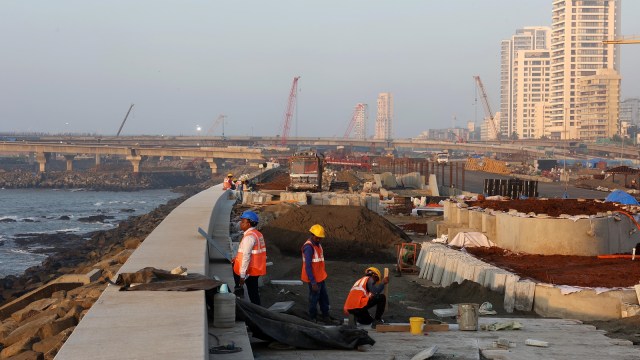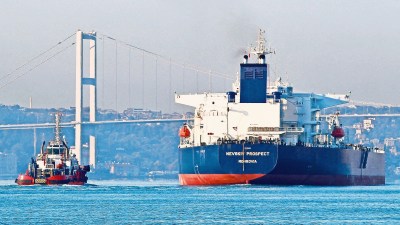Coastal road promenade that opens in Mumbai in May offers open recreational spaces, green pockets
While the tender on the themed stretches — the civic body has proposed five along the promenade — is yet to be floated, by May 2024, the Brihanmumbai Municipal Corporation (BMC) will throw open the 7.5-km pro-menade, along the main eight-lane carriageway for vehicles.
 Work on the promenade is underway. (Express photo by Amit Chakravarty)
Work on the promenade is underway. (Express photo by Amit Chakravarty)At Worli, 14 palm trees — recently translocated from nurseries in Kolkata, sway as they acquaint themselves with their new abode — the 7.5-kilometre promenade built as part of the coastal road. These trees are a part of a 120-metre themed stretch, a mock-up that the civic body plans on emulating at other pockets of the new promenade.
While the tender on the themed stretches — the civic body has proposed five along the promenade — is yet to be floated, by May 2024, the Brihanmumbai Municipal Corporation (BMC) will throw open the 7.5-km pro-menade, along the main eight-lane carriageway for vehicles.
The first stretch of the coastal road, which is an alternate route for north-south connectivity, comprises 10.58-kilometre high-speed MCRP corridor, which is being built by the BMC, and comes with the promise of development of recreational open public spaces and greenery.
Of the 111 hectares of land that has been reclaimed to make the coastal road a reality, the civic body has earmarked 70 hectares of the land parcel as open space, including the promenade as well as pockets earmarked for green spaces.
However, the civic body’s plan has drawn flak from city-based planners who fear that the present design of the mega road will cut away easy access to the city’s sprawling sea front.
Ahead of the coastal road opening, The Indian Express explores what the civic promise of 70 hectares of new open space entails and the contention raised by city’s architects.
The promenade
The 7.5-kilometre promenade, along the sea side of the coastal road, will have strolling area as well as a cycle track. A network of 11 pedestrian underpasses, under the main carriageway, is also being developed, along with five proposed green pockets with trees and sitting areas.
 The 7.5-kilometre promenade, along the sea side, will have strolling area as well as a cycle track. (Express photo by Amit Chakravarty)
The 7.5-kilometre promenade, along the sea side, will have strolling area as well as a cycle track. (Express photo by Amit Chakravarty)
A 120-metre mock-up of the proposed beautified stretch along the promenade has already propped up along the coastal road’s Worli section.
Modelled after a Hong Kong-based concept, this pilot stretch of the promenade is lined up with palm trees at every five metres, besides shrubs. According to the consultants, the pathway will be laden with tactile tiles for the differently abled, seating spaces, bike racks, water stations, smart poles, including CCTVs and decorative lighting.
Pawan Padiyar, planning head at HCC, who is one of the consultants, said, “Initially, the idea was to develop the patch similar to the Marine Drive promenade. However, on the basis of an alternate design by the consultants, we have prepared this mock-up on a stretch of 120 metres at Worli. There will be two pathways for the pedestrians at different levels along with a cycle track.”
He added, “Besides the 14 transplanted palm trees, shrubs and other plants have been brought from nurseries in Delhi, Gujarat and Pune. Only trees that are suitable for coastal areas are planted.”
Mantayya Swami, chief engineer of MCRP, said that the promenade is slated to open by May 2024. “For now, have readied this mock-up now, the other pockets will be developed later,” he said.
Green pockets
While the promenade will be along the sea, the other side of the carriageway — running parallel to the south-bound lane — will have open spaces where the civic body plans landscaping works. Senior BMC officials said that these areas will not be uniformly distributed, with the biggest open parcels being at Amarsons — Mahalaxmi, Haji Ali and Worli. The 11-metre wide median dividing the 17-metre wide carriageways will also be developed as a green patch.
According to chief engineer Swami, the landscaping works are yet to take off. “The tenders on the project are yet to be invited,” he said.
The civic body also plans coastal diversity park, parks for outdoor events, amphitheatres, wooden groves, butterfly garden, cycle and jogging track in these spaces.
The contention
The current alignment of the coastal road has drawn flak from city-based architects and urban planners who fear that it would break Mumbaikars’ connect with the seafront, restricting access and acting as a visual barrier. A group of architects have pitted an alternate proposal, which seeks a shift in the upcoming open spaces towards the seaside.
They believe that it will have the potential to improve the revenue and tourism along Mumbai’s waterfront, besides allowing the residents easy access to open space.
City-based architect Alan Abraham told The Indian Express, “The entire point of the reclamation, as opposed to building the road on a bridge, is that the coastline was a little curvy and the city needed open spaces. However, the current designs disconnects the city from the sea.”
Explaining the divide, he added, “Anyone from the city who wants to reach the sea side, will have to get down the steps of the underpasses, cross the huge stretch of 45-metre road and then climb up the stairs of the subway.”
A group of architects, urban planners, designers and principals of colleges of architecture had written a letter to the Maharashtra Chief Minister in March 2022 seeking a realignment of the way the coastal road had been planned.
“We think it wise to move as many of the open spaces to the seaside as possible– this would enable a world class waterfront open to all citizens retaining the much necessary vista on to the open uncluttered horizon,” read a part of the letter. Abraham also filed a PIL in Bombay High Court seeking changes to the proposed design.
Responding to questions, senior civic officials said, “The alternate plan proposed by architects is not technically feasible, according to the Indian Road Congress (IRC) codal provisions. Also, making a route along the sharp turns won’t be suitable.”
“Besides this, the alternate plan is agreeable if you do not have the access road. The Supreme Court has allowed for minimum reclamation. If we had developed the green space along the sea side, the court would have questioned our objectives — the primary one being connectivity,” they added.
The BMC said that with 84 per cent of the project completed, the PIL has come too late. However, Abraham said, “So what if the PIL came in late? The coastal road is here to stay for the next 100 years. If there is a better plan, it can still be implemented.”







